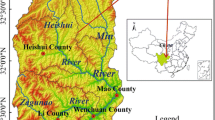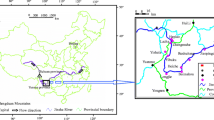Abstract
This research selected the Qipan gully as a study area for field investigation. The vulnerability of the population to debris flows in Qipan gully was assessed. Several valuation factors were considered such as family size, age structure, the physical condition of its members, ethnic characteristics, culture level, and distance to known debris flow events. A self-organizing map (SOM) approach was used in order to prevent man-made subjective factors in influencing evaluation index weights. MATLAB and ArcGIS were employed to determine the degree of population vulnerability to debris flow disaster. Population vulnerability of Qipan gully basin was mainly identified on densely populated places. The highest vulnerability was observed in a debris flow ditch mouth, which decreased to surrounding areas. Areas with extremely high-vulnerability and high-vulnerability degree featured a small percentage of the total area of the gully, with 3.52% and 4.90%, respectively. Extremely low-vulnerability and low-vulnerability degree areas exhibited high percentages of 22.98% and 60.06%, respectively. The analysis of the SOM U-matrix and the 18 variable planes hints that higher population vulnerabilities are related to medium or large families, with members of national minorities, primary education, and within 300 m to the debris flow gully. Age structure and members physical condition posed certain effects, but the degree of influence was low for this case study. The results can be used as a reference for reducing casualties in Qipan gully.






Similar content being viewed by others
References
Alexander DE (1993) Natural disasters. UCL Press Limited, London
Ding MT, Tellez RD, Hu KH (2010) Mapping vulnerability to debris flows based on SOM method. In: The 2nd international conference on computer and automation engineering, 2010, pp 393–398. https://doi.org/10.1109/ICCAE.2010.5451928
Ding MT, Heiser M, Hübl J, Fuchs S (2016) Regional vulnerability assessment for debris flows in China—a CWS approach. Landslides 13(3):537–550. https://doi.org/10.1007/s10346-015-0578-1
Finn WDL (1994) Geotechnical aspects of the estimation and mitigation of earthquake risk. Issues in urban earthquake risk. Springer, Dordrecht
Fuchs S, Thaler T (2018) Vulnerability and resilience to natural hazards. Cambridge University Press, Cambridge. https://doi.org/10.1017/9781316651148
Hu T, Huang RQ (2017) A catastrophic debris flow in the Wenchuan Earthquake area, July 2013: characteristics, formation, and risk reduction. J Mt Sci 14(1):15–30
Huang X, Tang C (2016) Quantitative risk assessment of catastrophic debris flows through numerical simulation. Adv Earth Sci 31(10):1047–1055
Hungr O, Fell R, Couture Réjean, Eberhardt E (2005) Landslide risk management. CRC Press, London
Jiang T, Xu PZ (1996) Community vulnerability assessment -anew approach for natural disaster studies. J Catastrophol 11(2):5–9
Kohonen T (1982) Self-organized formation of topologically correct feature maps. Biol Cybern 4(3):59–69. https://doi.org/10.1007/BF00337288
Kohonen T (2000) Self-Organizing Maps. 3rd Springer.
Kohonen T, Hynninen J, Kangas J, LaaksonenJ (1996) SOM_PACK: the self-organizing map program package. Helsinki University of Technology.
Kohonen T, Schroeder MR, Huang TS (2001) Self-organizing maps. Springer, Berlin.https://doi.org/10.1007/978-3-642-97966-8
Li CH, Li N (2007) Shi PJ (2007) On the cluster of pressure level of cultivated land and in China based on SOM. Resources and Environment in the Yangtze Basin 16(3):318–322
Li YS, Wei YL, Li HZ (1991) A primary study on economic and social benefits of disaster reduction. J Catastrophol 6(4):1–4
Luo Y, Long Y, Li P (1992) Evaluating principles for economic efficiency of preventing disaster engineering. J Catastrophol 7(4):7–10
Mejia-Navarro M, Wohl EE (1994) Geological hazard and evaluation using GIS: methodology and model applied to Medellin, Colombia. Environ Eng Geosci 31(4):459–481
Mora AM, Merelo JJ, Briones C, Morán F, Laredo JLJ (2007) Clustering and visualizing HIV quasispecies using Kohonen’s Self-Organizing Maps. In: International work-conference on artificial neural networks. Springer, Berlin, Heidelberg
Oja M, Kaski S, Kohonen T (2003) Bibliography of self-organizing map (SOM) papers: 1998–2001 addendum. Neural Comput Surv 3(1):1–156
Petley DN, Hearn GJ, Hart AB (2005) Towards the development of a landslide risk assessment for rural roads in Nepal. Social Science Electronic Publishing 137(6):123–150. https://doi.org/10.1007/978-90-6704-879-8_5
Tang C, Zhang J (2005) Vulnerability assessment of urban debris flow hazard. Journal of Catastrophology 20(2):11–15
United Nations (1992) Internationally agreed glossary of basic terms related to disaster management. Department of Humanitarian Affairs, DHA, Geneva
Wang SM, Zhao WJ, Huang HF (2013) A study of quantitative assessment method of population vulnerability of a single landslide. Hydrogeol Eng Geol 2(40):119–122
Xiang GP, Zhang DD (2015) Chang Ming et al. Hydrodynamics and debris flow-triggering conditions after Dam Break in Qipan Gully. Water Resour Power 33(04):143–146
Xu ZX (1985) The prevention and control of debris flow of Qipan Gully in Wenchuan County. Sichuan Province Mt Res 3(3):166–172
Xu J (2006) Assessing study of city mud-rock flow destruction-a case of Dongchuan, Yunnan. J Baoshan Teach Coll 5:83–87
Yu QD, Shen RF (1996) Assessment methods of disaster economic loss. J Catastrophol 11(2):10–14
Zeng C, Cui P, Ge YG (2014) Characteristics and mechanism of building damaged by debris flows on 11 July, 2013 in Qinpangou of Wenchuan, Sichuan. J Earth Sci Environ 36(2):81–91
Zhang XD, Wang YA (1996) Discussion on cost and benefit calculation method for disaster resistant engineering. J Catastrophol 11(2):1–3
Zhang GY, Yin KL (2007) Population vulnerability assessment on regional landslide hazards and casualty risk forecasting in Yongjia County, Zhejiang Province. Geol Sci Technol Inf 26(4):70–75
Zou Q, Cui P, Zeng C et al (2016) Dynamic process-based risk assessment of debris flow on a local scale. Phys Geogr 37(2):132–152. https://doi.org/10.1080/02723646.2016.1169477
Acknowledgements
This research was financially supported by the National key research and development program of China (Grant No. 2018YFC1505402), National Natural Science Foundation of China (Grant No. 41871174), and the Fundamental Research Funds for the Central Universities (Grant No. 2682019CX19).
Author information
Authors and Affiliations
Corresponding author
Additional information
Publisher's Note
Springer Nature remains neutral with regard to jurisdictional claims in published maps and institutional affiliations.
Rights and permissions
About this article
Cite this article
Ding, M., Huang, T. Vulnerability assessment of population in mountain settlements exposed to debris flow: a case study on Qipan gully, Wenchuan County, China. Nat Hazards 99, 553–569 (2019). https://doi.org/10.1007/s11069-019-03759-1
Received:
Accepted:
Published:
Issue Date:
DOI: https://doi.org/10.1007/s11069-019-03759-1




